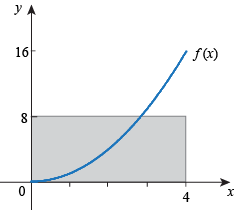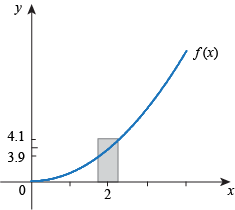Have a graphing calculator ready.
Sample Problem
Graph the function f(x) = 2x. This is a polynomial, which is continuous at every real number. In particular, it's continuous at x = 4, with f(4) = 8.
We're going to do some stuff using the fact that f is continuous at x = 4.
First, set the calculator window so 0 ≤ x ≤ 8 and 0 ≤ y ≤ 16.
We see this graph:

This gives us an idea of what the function looks like around the point (4, 8), which is exactly in the middle of the screen.
Now set the calculator window so that
7.5 ≤ y ≤ 8.5.
The graph now looks like this:

We don't like this graph. The reason we don't like it is that we can't see what the function is doing for all values of x in the window. We can't see what f(0) is or what f(8) is, for example, because the function vanishes out the top and bottom of the picture.
We'll restrict the x-values we're looking at. Since we're playing with continuity at x = 4, instead of letting x be 4 steps from 4 in either direction, we'll only let x be 2 steps from 4.
Set the calculator window so that 2 ≤ x ≤ 6.
The point (4,8) is still in the middle of the window. We still can't see what the function is doing for all values of x in the window, so we'll restrict x some more.
Let x be only 1 step away from 4 in either direction: 3 ≤ x ≤ 5.
Nope, we still don't like this graph.
How about 3.5 ≤ x ≤ 4.5?
Still don't like the graph.
What about 3.75 ≤ x ≤ 4.25?
Yes! We like this graph!
Now the graph is leaving at the sides, or corners, of the window:

We can see what the function is doing for every value of x in the window. Oh, and the point (4, 8) is still in the middle of the window. We now have what we want.
Playing with the calculator takes a while, but it's helpful for understanding what's going on. In the next section we'll see a shorter and tidier way to solve this problem.
Now we will recap what just happened.
1. We were given a continuous function f and a value c. In this case, f(x) = 2x, c = 4.
2. We decided that we only wanted to let y be 0.5 away from f(c). We only wanted y to be 0.5 away from f(4) = 8; that is, and we wanted y in between 7.5 and 8.5.
3. We restricted the values of x until we got what we wanted. We got a picture with (c, f(c)) (or (4,8)) in the middle of the window, and with f(x) between 7.5 and 8.5 for every value of x in the window.
A continuous function f comes with a guarantee: we can choose how far away we want to let f(x) move away from f(c), and if we restrict the x-values enough, we will find what we want. Essentially, we can zoom in or out of any portion of the continuous function.
There are two things to be aware of when restricting the x-values. First, we want to let x move the same distance away from c on either side. If c = 4, we wouldn't say 3 < x < 6, because then x could move away 1 step to the left but 2 steps to the right. Second, we want the result to be a picture, so we wouldn't say c ≤ x ≤ c. That graph would be the single dot.
The guarantee that we can restrict x to produce a picture is only good for continuous functions. Remember that x must move the same distance away from c on either side, and that we can't just say c ≤ x ≤ c.
Sample Problem
Let  .
.
From the graph, we can see that this function is discontinuous at x = 0:

Show that the "continuous function guarantee" fails for this function.
Answer.
If we try to restrict the x-values so that f(x) is within 0.5 of f(0) (that is, between 0.5 and 1.5), we're out of luck. Setting -0.5 ≤ x ≤ 0.5 doesn't produce what we want:

Neither does -0.1 ≤ x ≤ 0.1.

No matter how much we restrict x, we'll always have some negative <em>x</em>-values with <em>f</em>(<em>x</em>) = 0, and 0 is definitely not in the range of y-values that we're going for. We can't make the picture we want, which means the guarantee that works for continuous functions doesn't work on this function.
A brief digression: notice that the graphs we see usually look like lines. As we zoom in on each of these continuous functions, and restrict x and y a lot, we find a picture that looks more or less like a straight line. This idea will be handy later when we find linear approximations.
Example 1
Let f(x) = x2. This function is continuous at c = 2. How can we restrict x to guarantee that f(x) will be within 0.1 of f(c)? |




